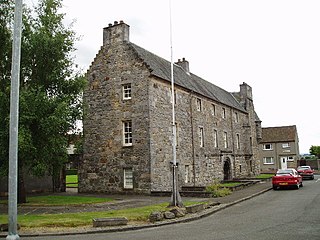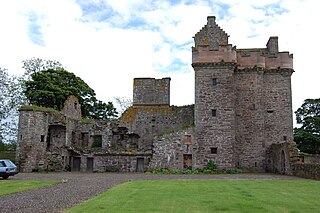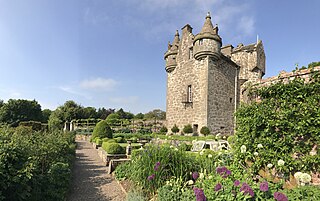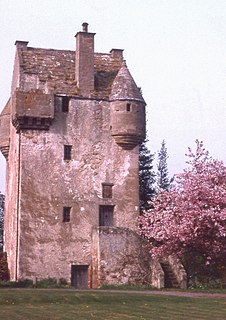
Gardyne's Land is a complex of five historic buildings on the High Street, Dundee, Scotland. They are the oldest domestic buildings in that city.

Gardyne's Land is a complex of five historic buildings on the High Street, Dundee, Scotland. They are the oldest domestic buildings in that city.
Gardynes Land consists of an L-plan three-storey merchant's house from around the year 1560; lodgings from around 1640; a tenement from around 1790; a billiard hall from around 1820 and a Victorian retail unit from around 1845. [1] All five Gardynes Land buildings are Category A listed buildings. [2] [3]
Gardynes Land came to the attention of the Tayside Building Preservation Trust in 1995. [4] Between 1997 and 2000, the Trust acquired the buildings and raised funds for their restoration. A first phase of wind and waterproofing works started in 2000. Between 2000 and 2003, a professional team were appointed and plans were first drawn up and approved for converting the complex into a hostel. [4] In April 2005, the Gardynes Land project was handed over to the Dundee City Council.
The Gardyne's Land restoration has received awards from the Dundee Civic Trust, the Dundee Institute of Architects, the Royal Town planning institute, a Scottish award for quality in planning and regeneration and renewal magazine. [4]

Dundee is Scotland's fourth-largest city and the 51st-most-populous built-up area in the United Kingdom. The mid-year population estimate for 2016 was 148,280, giving Dundee a population density of 2,478/km2 or 6,420/sq mi, the second-highest in Scotland. It lies within the eastern central Lowlands on the north bank of the Firth of Tay, which feeds into the North Sea. Under the name of Dundee City, it forms one of the 32 council areas used for local government in Scotland.

Castle Menzies in Scotland is the ancestral seat of the Clan Menzies and the Menzies Baronets. It is located a little to the west of the small village of Weem, near Aberfeldy in the Highlands of Perthshire, close to the former site of Weem Castle, destroyed c. 1502.

Broughty Ferry is a suburb of Dundee, Scotland. It is situated four miles east of the city centre on the north bank of the Firth of Tay. The area was a separate burgh from 1864 until 1913, when it was incorporated into Dundee. Historically it is within the County of Angus.
The Royal Incorporation of Architects in Scotland (RIAS) is the professional body for architects in Scotland.

Cairness House, 4.5 miles (7 km) south-east of Fraserburgh in Buchan in the county of Aberdeenshire, is a country house built in the Neoclassical style between 1791 and 1797 to designs by architect James Playfair. It replaced an earlier house of 1781 by Robert Burn, which was in part incorporated into the Playfair scheme. Sir John Soane assisted in the final stages of the construction after Playfair's death in 1794. The park was laid out by Thomas White, a follower of Lancelot 'Capability' Brown.

Crimonmogate is an estate near Crimond, Aberdeenshire. The estate formed part of Lonmay parish, dates back to the 14th century, and was included in the lands owned by the powerful Earls of Erroll. The estate was sold by Mary Hay, 14th Countess of Erroll, in the 1730s.

Powrie Castle is a ruined 16th-century castle located in the north of Dundee, Scotland. It was designated as a scheduled monument in 1971. The early 17th-century north range of the castle is now a separate fortified house and has been converted into a private residence. It itself is a Category A listed building.

Ballumbie is a residential area on the north-east edge of Dundee, Scotland. The area was formerly an estate centred on Ballumbie Castle, a mid-16th-century fortification, which was followed by the 19th-century Ballumbie House. There is also a golf course surrounded by a medieval wall and the site of a late medieval parish church. The castle and house are located just outside the City of Dundee, in Angus.

Longside is a village located in Aberdeenshire, Scotland and consists of a single main street. It lies seven miles inland from Peterhead and two miles from Mintlaw on the A950. Its population in 2001 was 721. The River Ugie flows through it.
Longforgan is a village and parish in the Carse of Gowrie, in Perth and Kinross, Scotland. It lies 5 miles west of Dundee on the main A90 road.

Menstrie Castle is a three-storey manor house in the town of Menstrie, Clackmannanshire, near Stirling, central Scotland. From the early 17th century, it was home to Sir William Alexander, 1st Earl of Stirling, who was instrumental in founding the colony of Nova Scotia. It was later owned by the Holburn or Holborne family, who were created Baronets of Menstrie in 1706. The castle was restored in the 20th century, won a Civic Trust award, and now incorporates holiday accommodation, private flats, and a museum and cafe run by the National Trust for Scotland.

Melgund Castle, lying around two kilometres (1.2 mi) due east of Aberlemno in Angus, Scotland, is a 16th-century L-plan castle which has been partially restored as a private residence. It was designated as a scheduled monument in 1971.

Verdant Works, also known as Scotland's Jute Museum, is a former jute mill in the Blackness area of Dundee, Scotland. It was purchased in 1991 by the Dundee Heritage Trust. The trust restored the buildings, which were officially opened by Prince Charles in 1996, as a museum dedicated to the textile industry, an industry that once dominated the city's economy.

Gardyne Castle is a 16th-century tower house in Angus, Scotland. It is located 2 kilometres (1.2 mi) south-west of Friockheim. The castle is still in use as a family home, and is protected as a Category A listed building.

The Egyptian Halls is a category A listed building at 84–100 Union Street, Glasgow, Scotland. It was built between 1870–72 and designed by Alexander "Greek" Thomson. Other than some retailers on the ground floor, the building is currently unoccupied. Despite several attempts at restoration, it remains in a parlous state and was under threat of demolition in 2011. Planning approval and listed building consent has since been given for a scheme which has secured funding for conversion to a 114-bed four-star hotel. As of 20 February 2013, subsidy was still being sought for work to the ground floor.
Charles McKean FRSE FRSA FRHistS FRIBA was a Scottish historian, author and scholar.

The Howff is a burial ground in the city of Dundee, Scotland. Established in 1564, it has one of the most important collections of tombstones in Scotland, and is protected as a category A listed building.

Dyke Parish Church is a Georgian church in Dyke, a village in Moray. In active use by the Church of Scotland since it was built in 1781, it stands on the site of a mediaeval church, and incorporates an older mausoleum, which is now the church hall and vestry. An early mediaeval Pictish cross slab, and a twelfth century coin hoard were discovered in the grounds while the church was being built. It was designated a Category A listed building in 1971.

Coxton Tower is a late sixteenth-century tower house in Moray, Scotland. Heavily fortified, it was built around 1590, with substantive repairs in 1635 and 1645, but its design is reminiscent of much older buildings. It has not been occupied since around 1867 except to house Canadian soldiers during the Second World War, but was renovated in 2001 to help protect the fabric of the structure, which is designated a Category A listed building.
| Wikimedia Commons has media related to Gardyne's Land . |